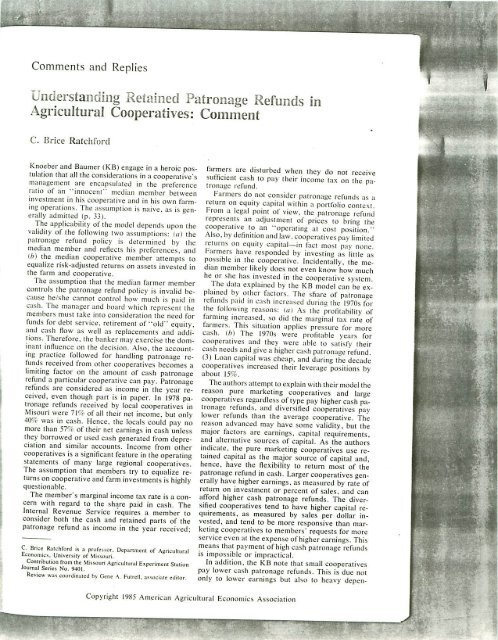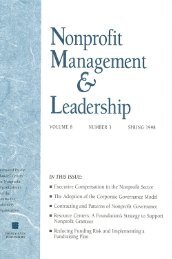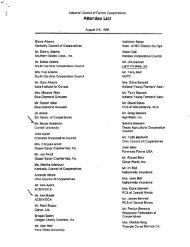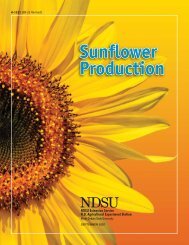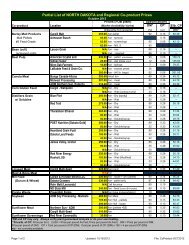Understanding Retained Patronage Refunds in Agricultural
Understanding Retained Patronage Refunds in Agricultural
Understanding Retained Patronage Refunds in Agricultural
Create successful ePaper yourself
Turn your PDF publications into a flip-book with our unique Google optimized e-Paper software.
Comments and Replies<br />
<strong>Understand<strong>in</strong>g</strong> <strong>Reta<strong>in</strong>ed</strong> <strong>Patronage</strong> <strong>Refunds</strong> <strong>in</strong><br />
<strong>Agricultural</strong> Cooperatives: Comment<br />
C. Brice Ratchford<br />
Knoeber and Baumer (KB) engage <strong>in</strong> a heroic posmlaiion<br />
thai all the considerations <strong>in</strong> a cooperaiive's<br />
management are encapsulated <strong>in</strong> [he preference<br />
ratio of an "<strong>in</strong>nocent" median member between<br />
<strong>in</strong>vestment <strong>in</strong> his cooperative and <strong>in</strong> his own farm<br />
<strong>in</strong>g operations. The assumption is naive, as is gen<br />
erally admitted (p. 331.<br />
The applicability of the model depends upon ihe<br />
validity of the follow<strong>in</strong>g two assumpiions: (a) the<br />
patronage refund policy is determ<strong>in</strong>ed by [lie<br />
median member and reflects his preferences, and<br />
ib) the median cooperative member attempts to<br />
equalize risk-adjusted returns on assets <strong>in</strong>vested <strong>in</strong><br />
(he farm and cooperative.<br />
The assumption [hat the median farmer member<br />
controls the patronage refund policy is <strong>in</strong>valid be<br />
cause he/she cannot control how much is paid <strong>in</strong><br />
cash. The manager and board which represent the<br />
members must take <strong>in</strong>to consideration the need for<br />
lunds for debt service, retirement of "old" equity,<br />
and cash How as well as replacements and addi<br />
tions. Therefore, the banker may exercise the dom<br />
<strong>in</strong>ant <strong>in</strong>fluence on the decision. Also, the account<br />
<strong>in</strong>g practice followed for handl<strong>in</strong>g patronage re<br />
funds received from other cooperatives becomes a<br />
limit<strong>in</strong>g factor on the amount of cash patronage<br />
refund a particular cooperative can pay. <strong>Patronage</strong><br />
refunds are considered as <strong>in</strong>come <strong>in</strong> the year re<br />
ceived, even though part is <strong>in</strong> paper. In 1978 pa<br />
tronage refunds received by local cooperatives <strong>in</strong><br />
Misouri were 7]C-r of all their net <strong>in</strong>come, but only<br />
40% was <strong>in</strong> cash. Hence, the locals could pay no<br />
more than 57% of their net earn<strong>in</strong>gs <strong>in</strong> cash unless<br />
they borrowed or used cash generated from depre<br />
ciation and similar accounts. Income from other<br />
cooperatives is a significant feature <strong>in</strong> the operat<strong>in</strong>g<br />
statements of many large regional cooperatives.<br />
The assumption that members try to equalize re<br />
turns on cooperaiive and farm <strong>in</strong>vestments is highly<br />
questionable.<br />
The member's marg<strong>in</strong>al <strong>in</strong>come tax rate is a con<br />
cern with regard to the share paid <strong>in</strong> cash. The<br />
Internal Revenue Service requires a member to<br />
consider both the cash and reta<strong>in</strong>ed pans of the<br />
patronage refund as <strong>in</strong>come <strong>in</strong> the year received;<br />
C- Brke Raldlford is a profe^or. Depi,rm,1;,u of <strong>Agricultural</strong><br />
fcconomics. University of Mi\si>uri.<br />
Contribution from Lhc Mmouri <strong>Agricultural</strong> Experiment Station<br />
Juumal Scr.c:, No. 9401.<br />
Renew was coord<strong>in</strong>ated by Gene A. Fulrell. associate editor.<br />
farmers are disturbed when they do not receive<br />
sufhcient cash to pay their <strong>in</strong>come tax on the pa<br />
tronage refund.<br />
Farmers do not consider patronage refunds as a<br />
return on equity capital with<strong>in</strong> a portfolio context<br />
From a legal po<strong>in</strong>t of view, the patronage refund<br />
represents an adjustment of prices lo br<strong>in</strong>g ihe<br />
cooperative to an "operat<strong>in</strong>g at cosi position "<br />
Also, by def<strong>in</strong>ition and law. cooperatives pay limited<br />
returns on equity capital—<strong>in</strong> fact most pay none.<br />
Farmers have responded by <strong>in</strong>vest<strong>in</strong>g as little as<br />
possible <strong>in</strong> the cooperative. Incidentally, the me<br />
dian member likely does not even know how much<br />
he or she has <strong>in</strong>vested <strong>in</strong> the cooperaiive system<br />
Ihe data expla<strong>in</strong>ed by the KB model can be ex<br />
pla<strong>in</strong>ed by other factors. The share of patronage<br />
refunds paid <strong>in</strong> cash <strong>in</strong>creased dur<strong>in</strong>g ihe 1970s for<br />
the follow<strong>in</strong>g reasons: (a) As the probability of<br />
farm<strong>in</strong>g <strong>in</strong>creased, so did the marg<strong>in</strong>al tax rate of<br />
farmers. This situation applies pressure for more<br />
cash, (b) The 1970s were profitable years for<br />
cooperatives and they were able to satisfy their<br />
cash needs and give a higher cash patronage refund<br />
(3) Loan capital was cheap, and dur<strong>in</strong>g the decade<br />
cooperatives <strong>in</strong>creased their levcraee positions bv<br />
about 15%.<br />
The authors attempt lo expla<strong>in</strong> with their model the<br />
reason pure market<strong>in</strong>g cooperatives and large<br />
cooperatives regardless of type pay higher cash pa<br />
tronage refunds, and diversified cooperatives pay<br />
lower refunds than the average cooperative. The<br />
reason advanced may have some validity, but the<br />
major factors are earn<strong>in</strong>gs, capital requirements,<br />
and alternative .sources of capital. As the authors<br />
<strong>in</strong>dicate, the pure market<strong>in</strong>g cooperatives use re<br />
ta<strong>in</strong>ed capital as the major source of capital and.<br />
hence, have the flexibility to return most of the<br />
patronage refund <strong>in</strong> cash. Larger cooperatives gen<br />
erally have higher earn<strong>in</strong>gs, as measured by rate of<br />
return on <strong>in</strong>vestment or percent of sales, and can<br />
afford higher cash patronage refunds. The diver<br />
sified cooperatives lend to have higher capital re<br />
quirements, as measured by sales per dollar <strong>in</strong><br />
vested, and tend to be more responsive than mar<br />
ket<strong>in</strong>g cooperatives to members" requests for more<br />
service even at the expense of higher earn<strong>in</strong>gs. This<br />
means that payment of high cash patronage refunds<br />
is impossible or impractical.<br />
In addition, the KB note that small cooperatives<br />
pay lower cash patronage refunds. This is due not<br />
only to lower earn<strong>in</strong>gs but also to heavy depen-<br />
Copyright 1985 American <strong>Agricultural</strong> Economics Association<br />
' «
114 February 1985<br />
dence on patronage refunds from other coopera<br />
tives, ihe majority of which is <strong>in</strong> paper.<br />
While usefulness of KB's model is limited be<br />
cause of [he restricted assumptions necessary to<br />
apply i[ to cooperatives, it allows one to test several<br />
<strong>in</strong>terest<strong>in</strong>g hypotheses. The decision on reta<strong>in</strong>ed<br />
patronage refunds is a good place to start look<strong>in</strong>g<br />
al ihe entire decision-mak<strong>in</strong>g process used by<br />
cooperatives, ll is a critical economic and psycho<br />
logical issue thai has both short- and long-run im<br />
pact on the entire operation.<br />
This comment gives reasons for question<strong>in</strong>g the<br />
validity of the two basic assumptions <strong>in</strong> the KB<br />
Amrr. J. Agr. Earn.<br />
model. Also, factors and conditions not <strong>in</strong>cluded <strong>in</strong><br />
the model are identified that can expla<strong>in</strong> the data<br />
used to support the validity of the model.<br />
Reference<br />
[Received July 1983; f<strong>in</strong>al revision<br />
received March 1984.]<br />
Knocber, Chirk R.. anil David L, Baumer. "Undemand<br />
<strong>in</strong>g <strong>Reta<strong>in</strong>ed</strong> <strong>Patronage</strong> <strong>Refunds</strong> <strong>in</strong> <strong>Agricultural</strong><br />
Cooperatives." Amtr.J.Agr, Econ. 65(19831:30-37.
<strong>Understand<strong>in</strong>g</strong> <strong>Reta<strong>in</strong>ed</strong> <strong>Patronage</strong> <strong>Refunds</strong> <strong>in</strong><br />
<strong>Agricultural</strong> Cooperatives: Reply<br />
Charles R. Knoeber and David L. Baumer<br />
In his comment on our paper, Ratchford makes two<br />
broad po<strong>in</strong>ts. First, our model is "naive" and un-<br />
Sliited to expla<strong>in</strong><strong>in</strong>g cooperative behavior. Second,<br />
alternative explanations of some of our empirical<br />
f<strong>in</strong>d<strong>in</strong>gs are presented. We address these <strong>in</strong> order.<br />
We view an important contribution of our paper<br />
to be the development of a simple (not naive) model<br />
<strong>in</strong> which maximiz<strong>in</strong>g behavior generates testable<br />
hypotheses. In order to do this, cooperative mem<br />
bers are treated as rational maximizers and (by use<br />
of a median voter approach] the ultimate determi<br />
nants of cooperative f<strong>in</strong>ancial behavior. We are<br />
criticized on both counts. Ratchford asserts that<br />
farmers do not know what they have <strong>in</strong>vested <strong>in</strong> the<br />
cooperative and do not consider this <strong>in</strong>vestment as<br />
a part of their portfolio of assets. More succ<strong>in</strong>ctly,<br />
farmers are not rational maximizers. We th<strong>in</strong>k this<br />
is a peculiar and counterfactual assertion. More<br />
over, it precludes any economic analysis. Ratch<br />
ford also asserts that laws, bankers' rules, and ac<br />
count<strong>in</strong>g practices, not the desires of members, de<br />
term<strong>in</strong>e the f<strong>in</strong>ancial behavior of cooperatives.<br />
While we admit that legal rules, tax laws, and other<br />
<strong>in</strong>stitutional arrangements limit the range of f<strong>in</strong>an<br />
cial decision mak<strong>in</strong>g by cooperatives, they do not<br />
elim<strong>in</strong>ate it. Indeed, the share of patronage refunds<br />
reta<strong>in</strong>ed varies considerably across cooperatives.<br />
Ratchford offers no way to expla<strong>in</strong> this variation.<br />
We do. Our approach, which presumes control by a<br />
median member is admittedly extreme, but it seems<br />
closer to reality than the approach offered by<br />
Ratchford which allows no member <strong>in</strong>fluence on<br />
cooperative decision mak<strong>in</strong>g.1 In sum, our model<br />
Charles R. Knoeber is an associate professor, and David L.<br />
Haunier is an assistant professor. Department of I;conumics and<br />
Bus<strong>in</strong>ess. North Carol<strong>in</strong>a State University.<br />
Review was coord<strong>in</strong>ated by Kichard !-. Just, editor.<br />
1 <strong>in</strong>deed. Ratchford's <strong>in</strong>itial strong staiemeni [hat "The as<br />
sumption that [he median farmer controls patronage refund policy<br />
is <strong>in</strong>valid because he cannol control how much is paid <strong>in</strong> cash" is<br />
contradicted by his later argument thai retention policy is con<br />
stra<strong>in</strong>ed by members who are "disturbed) when they do not<br />
receive sufficient cash to pay their <strong>in</strong>come lax on the patronage<br />
refund." Member preferences matter, and we have modeled This<br />
<strong>in</strong> a median voter framework. Alternatively, we could have ap<br />
pealed To The voluntary nature of cooperative membership. Mem<br />
bers "disturbed" by decisions of a cooperative manager may<br />
"vote with their feel" by leav<strong>in</strong>g The cooperative and <strong>in</strong> this way<br />
<strong>in</strong>fluence cooperative decision mak<strong>in</strong>g.<br />
offers a simple framework for analyz<strong>in</strong>g coopera<br />
tive behavior and provides straightforward hypoth<br />
eses. Webelieve this is clearly preferable to a litany<br />
of <strong>in</strong>stitutional constra<strong>in</strong>ts which provides neither a<br />
cohesive framework nor testable implications.<br />
We provide two sons of empirical support for our<br />
model. First, we suggest possible explanations (fol<br />
low<strong>in</strong>g from our model) for some differences across<br />
time and across cooperatives by type <strong>in</strong> the aggre<br />
gate share of patronage refunds reta<strong>in</strong>ed. Second,<br />
we estimate cross-section regressions on major<br />
farm supply cooperatives.2 We do not f<strong>in</strong>d alterna<br />
tive explanations of the aggregate data surpris<strong>in</strong>g.<br />
Our <strong>in</strong>tent was only to suggest a model consistent<br />
with widely known "facts" about reta<strong>in</strong>ed patron<br />
age refunds. Compet<strong>in</strong>g explanations are surely<br />
available. Their existence docs not weaken the em<br />
pirical case for our model. Only if compet<strong>in</strong>g mod<br />
els make different predictions can the superiority of<br />
one be established empirically. Indeed, our crosssection<br />
results which Ratchford ignores can be<br />
viewed as just such a test. Our model suggests that<br />
the variance of the rate of return on cooperative<br />
equity capital (a partial measure of the risk<strong>in</strong>ess of<br />
this part of the farmer's portfolio) will be negatively<br />
related to the share of patronage refunds reta<strong>in</strong>ed.<br />
RatchTord's approach suggests this variable will be<br />
unrelated to cooperative retentions (s<strong>in</strong>ce the share<br />
of patronage refunds reta<strong>in</strong>ed is not affected by<br />
members' portfolio desires]. The negative relation<br />
we f<strong>in</strong>d provides empirical support for the superior<br />
ity of our model.<br />
[Received August 1984: no revision.]<br />
'■ While we refra<strong>in</strong> generally from comment<strong>in</strong>g on the ad hoc<br />
reasons offered by Ralchford lor patterns <strong>in</strong> the aggregate data on<br />
patronage refunds reta<strong>in</strong>ed, one error <strong>in</strong> logic should be po<strong>in</strong>ted<br />
out. The <strong>in</strong>creased profitability of farm<strong>in</strong>g <strong>in</strong> the 197ns and its<br />
<strong>in</strong>leraction with the marg<strong>in</strong>al lax rate will nol create "pressure for<br />
more cash." First, this <strong>in</strong>creased profitability (as we measured it)<br />
is largely due lo appreciation <strong>in</strong> Ihe value of farm land. This<br />
appreciation is untaieil if i[ is unrealized. Second, to the extcnl<br />
that farmers realized higher <strong>in</strong>comes <strong>in</strong> Ihe 19711s and also faced<br />
higher marg<strong>in</strong>al tax rales, ihey found themselves with abnormally<br />
large (not Mnalll amounts of c.ish creat<strong>in</strong>g no pressure for higher<br />
cash palronago refunds.<br />
Copyright 1985 American <strong>Agricultural</strong> Economics Association


